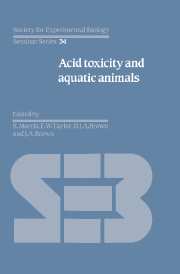Book contents
- Frontmatter
- Contents
- Contributors
- Units, Symbols and Formulae
- Preface
- Introduction: The causes and consequences of surface water acidification
- Invertebrate communities in acid streams
- Fish survival in acid waters
- Field studies on fisheries in acid waters in the UK
- Episodic changes in water quality and their effects on fish
- Acid–base regulation in fishes: 1. Mechanisms
- Acid–base regulation in fishes: 2. Biological responses and limitations
- Intracellular pH regulation and the effects of external acidification
- The physiological problems of fish in acid waters
- Laboratory studies on invertebrate survival and physiology in acid waters
- The physiological problems of crayfish in acid waters
- The effects of hydrogen and aluminium ions on fish gills
- The combined effects of pH and trace metals on fish ionoregulation
- Endocrine responses to acid stress in fish
- Commentary and conclusions
- Index
Fish survival in acid waters
Published online by Cambridge University Press: 05 February 2012
- Frontmatter
- Contents
- Contributors
- Units, Symbols and Formulae
- Preface
- Introduction: The causes and consequences of surface water acidification
- Invertebrate communities in acid streams
- Fish survival in acid waters
- Field studies on fisheries in acid waters in the UK
- Episodic changes in water quality and their effects on fish
- Acid–base regulation in fishes: 1. Mechanisms
- Acid–base regulation in fishes: 2. Biological responses and limitations
- Intracellular pH regulation and the effects of external acidification
- The physiological problems of fish in acid waters
- Laboratory studies on invertebrate survival and physiology in acid waters
- The physiological problems of crayfish in acid waters
- The effects of hydrogen and aluminium ions on fish gills
- The combined effects of pH and trace metals on fish ionoregulation
- Endocrine responses to acid stress in fish
- Commentary and conclusions
- Index
Summary
Introduction
This paper will review the field and laboratory data on the chemical factors which affect fish and fishery survival in acid waters, and an attempt will be made to relate the two sets of data where this is possible. In general, the field data being considered are predominantly from Norway where the fish species is mainly brown trout, but, where relevant, data from North America will be described. Data from the UK are dealt with by Turnpenny (this volume).
The main chemical factors, other than pH (hydrogen ion concentration) that will be discussed are calcium (hardness) and aluminium concentration. The aquatic chemistry of aluminium, which is generally present in higher concentrations in more acid waters, is complex and it is necessary at this stage to summarise the details on the subject given by Freeman & Everhard (1977), Burrows (1977), Hunter et al. (1980), Spry et al. (1981) and O'Donnell et al. (1983).
Solubility of aluminium is a direct function of ambient pH, being at a minimum at around pH 5.5, and increasing towards both extremes of the pH scale. Soluble cationic species e.g. A13+, A1OH2+ and Al(OH)2+, are formed at pH levels less than 5.5, and soluble aluminate species, e.g. Al(OH)4-, predominate at pH levels greater than 5.5. In natural waters, aluminium has a strong tendency to form complexes with other anions capable of forming coordinate bonds – for example, six different fluoride complexes are known (Burrows, 1977).
- Type
- Chapter
- Information
- Acid Toxicity and Aquatic Animals , pp. 31 - 44Publisher: Cambridge University PressPrint publication year: 1989
- 34
- Cited by



